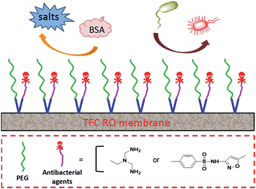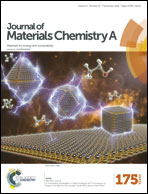One-step bimodel grafting via a multicomponent reaction toward antifouling and antibacterial TFC RO membranes†
Abstract
Simple methods for dual functional modification of membrane surfaces have been rarely reported but are highly desirable for the fabrication of antifouling and antibacterial membranes. In this work, we exploit a multicomponent reaction, Ugi-4CR (Ugi four-component reaction), to prepare novel antifouling and antibacterial reverse osmosis (RO) membranes. With the aid of the high number of residual carboxyl groups on a commercial polyamide RO membrane as the anchor and methyl isocyanoacetate as a component, a hydrophilic macromolecular component, methoxy poly(ethylene glycol) aldehyde (MPEG-CHO), and an amino-terminated antibacterial component, tris(2-aminoethyl)amine (TAEA) or sulfamethoxazole (SMZ), were grafted onto the surface in a single step via the Ugi-4CR. The surfaces of the original and modified membranes were characterized by ATR-FTIR, XPS, TG, WCA, FESEM and AFM measurements. The antifouling performance was evaluated by cross-flow filtration of protein and inorganic salt solution. The antibacterial performance was assessed by the shake flask method. The results show that the Ugi-4CR was successfully conducted on the RO membrane surface and that MPEG-CHO and the antibacterial agents were successfully grafted. The surface roughness decreased and surface the hydrophilicity improved upon modification. After 48 h fouling experiments, the obtained PA-g-PEG/TAEA and PA-g-PEG/SMZ membranes showed obviously lower flux attenuation ratios and higher flux recovery ratios than the original membrane in both cases when fouled by protein or inorganic salt. In addition, the bacterial concentrations in the suspensions shook with the modified membranes were much lower than that of the original membrane. As for the PA-g-PEG/SMZ membrane, hardly any bacterial growth was seen, even after 24 h culture. In contrast to current multi-step grafting processes, this work reports a “one pot” procedure with two functional groups grafted simultaneously under very mild conditions without the use of any catalyst.


 Please wait while we load your content...
Please wait while we load your content...